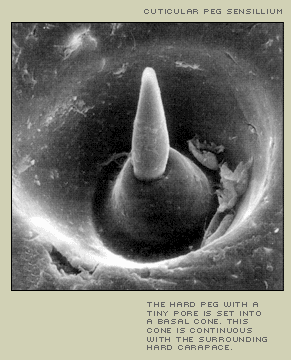Structure of the Cord
The horseshoe crab has a remarkable number of cuticular receptors that provide neural input to the nervous system. Probably the most common to the limulus is the small cuticular peg sensillum. These are found over the entire surface of the horseshoe and are especially concentrated along the edges, ridges and spines of its body. There are conservatively about 60,000 sensilla on the surface of the prosoma and an additional 40,000 on the opithosoma and appendages. These are what let the horseshoe "feel"
The pit sensilla are the chemosensory equivalent of the peg sensilla. They are external pores that either flush with the surface or widen to a shallow cup. The opening provides the dendrite (a long branching outgrowth from a neuron) access to the surrounding water. These are the predominant receptors of the sensory spines, especially the appendages.
These receptors together provide an astonishing neural input to the central nervous system. Each sensilla contains between 3 and 15 sensory cells. Much of it comes from the appendages, with an estimated 3-4 million fibers from the chelae (pincers), 1 million from the gnathobasal spines, 1 million from the flabellum and 1 million from the branchial warts. Adding the 1 million neural fibers from the peg sensilla, the horseshoe crab has about 7 million axons that allow it to feel and sense the world around it.
